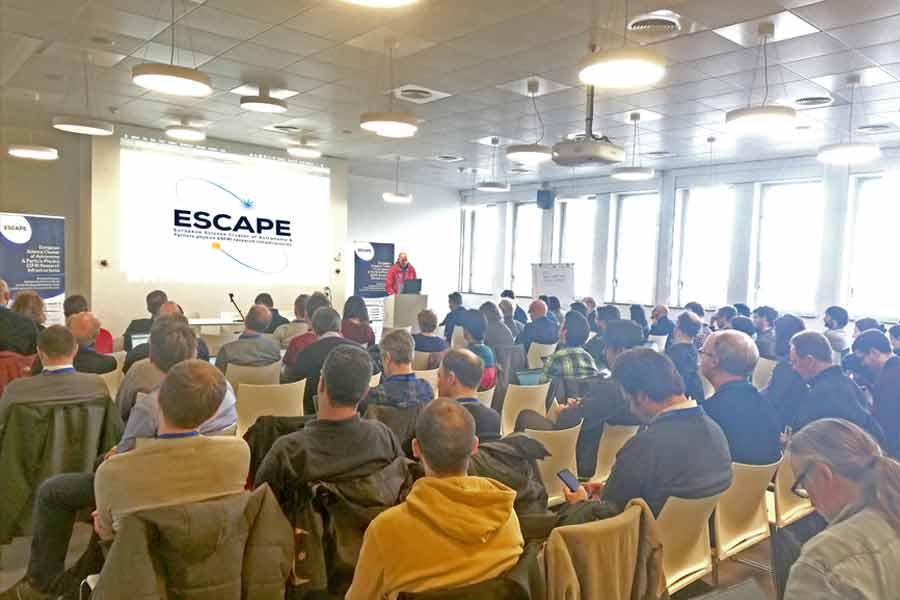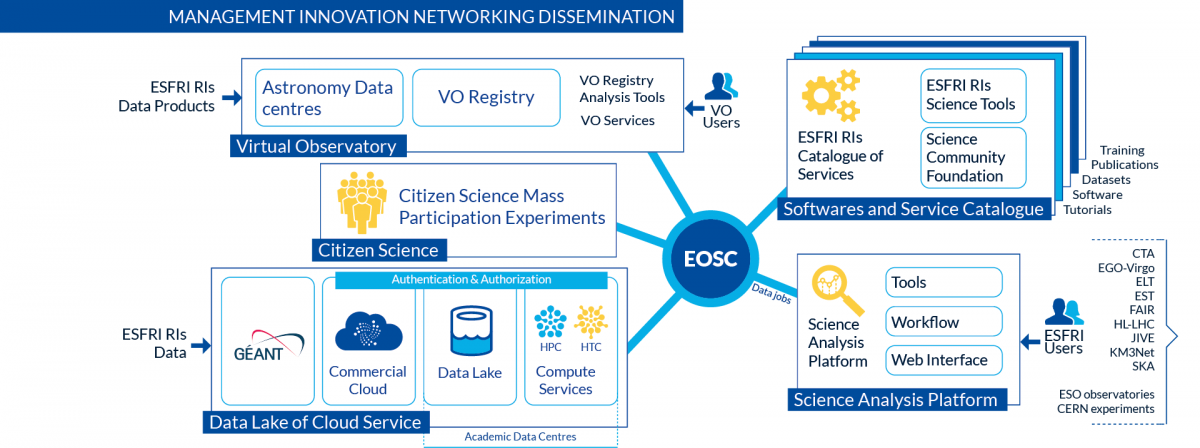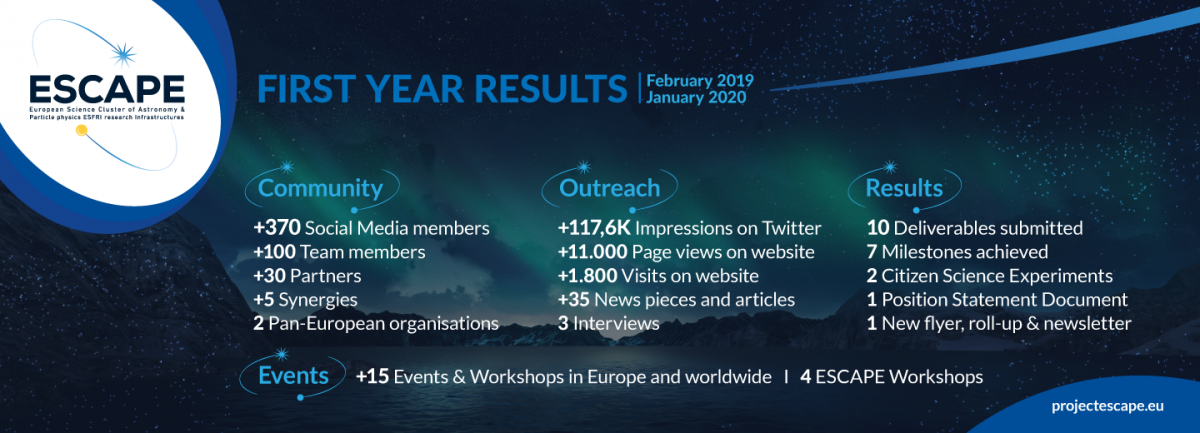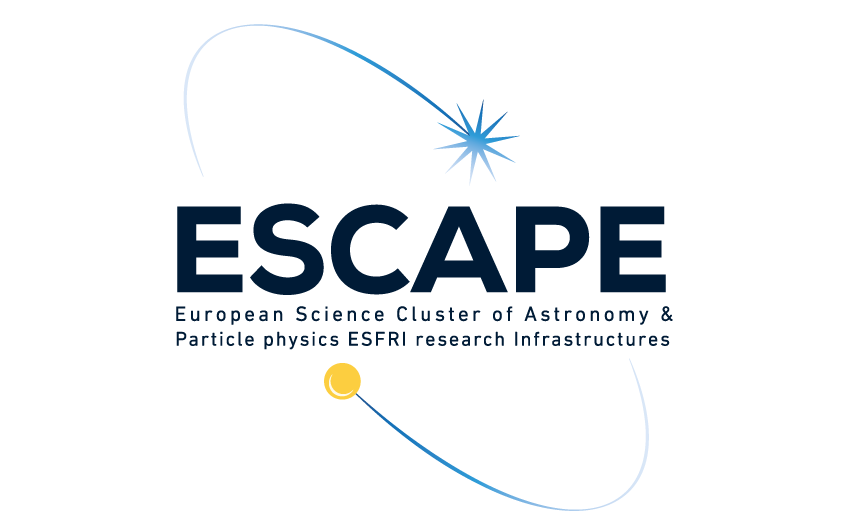

Open science promotes collaborations that are key to pushing the boundaries of data-driven scientific research, by connecting researchers across the globe and increasing discoverability and visibility. The ESCAPE Horizon 2020 project is the European Science Cluster of Astronomy and Particle Physics that provides an open-source scientific software and service repository. Its goal is to enable open science as part of the drive to a European Open Science Cloud (EOSC).
To take stock of progress, ESCAPE organised a meeting in late February at the Royal Library of Belgium, bringing together the consortium members, its General Assembly members and External Expert Advisory Board members, as well as EOSC stakeholders.
The meeting zoomed in on the main results achieved during the first year of ESCAPE in the drive towards the development of the “ESCAPE Astronomy and Particle/Nuclear Physics Cell” that will enable EOSC to adopt services transversally, and coupled with e-infrastructures that will help support other disciplinary “cells”. Now entering its second year, ESCAPE is looking forward to sharing its outcomes and engaging with its ESCAPE stakeholder community.

ESCAPE is creating a cross-border, multi-disciplinary environment that benefits both EOSC and the ESFRI projects, by exploring standards, prototyping and deploying advanced open data services that follow FAIR principles of findable, accessible, interoperable and reusable across the various stages of the scientific process. The five services of ESCAPE provide innovative solutions for the management, curation, and deposition of data, for the data driven science economy, spanning major domains in fundamental research: astronomy, astrophysics, astroparticle physics, high energy physics, particle and nuclear physics. ESCAPE service factsheets with details on functionalities in each one with rollout over the project’s 42-month lifecycle.
The ESCAPE community was created early on in the project and now counts more than 350 members from Twitter and LinkedIn as some of the main stakeholder engagement channels to raise awareness and share updates on ESCAPE, including, the website, communication materials, participation at third-party events worldwide and the organisation of ESCAPE workshops.

Other Highlights of Year 1
Year 1 was the ramp-up period to set up the main tasks to develop ESCAPE services. The “ESCAPE Virtual Observatory” started the interaction with a variety of organisations to test service publishing, as well as identified some requirements from the ESFRI projects to use the services, as well as the “ESCAPE Science Analysis Platform”. “ESCAPE Open-source scientific Software and Service Repository” created five focus groups to better support the creation of an open data access repository towards open science. “ESCAPE Data Infrastructure for Open Science” defined the implementation plan and the design of the pilot Implementation plan and the design of the of the data lake pilot, with an assessment of the first version in a year time. “ESCAPE Citizen Science” launched its first experiment, called Clump Scout, with over 720 thousand classifications from over 6.500 volunteers.
An Open Science Vision
Open science promotes collaborations, taking analyses to new frontiers through enhanced data research. Practising open science makes it easier for researchers to connect with each other because it increases the discoverability and visibility of their work. This, in turn, enables easy access to novel data and software resources. Sharing data and knowledge transfer within and across scientific communities is crucial for accelerating scientific discoveries and increasing the value of research. ESCAPE is the key driver of this vision for astronomy, astroparticle and particle physics.
Towards a data-driven science – the EOSC
Corina Pascu, Policy Officer of the European Open Science & Open Science Cloud, who joined ESCAPE meeting, stated that “1.9 million European researchers and 70 million professionals in science and technology a trusted open distributed environment providing seamless access to data and interoperable services addressing the whole research data life cycle”. The main goal of EOSC is to give Europe a global lead in research data management, as well as enable interdisciplinary research to address societal challenges. EOSC will allow researchers to discover & access resources and services from different countries and disciplines.

It is important to highlight that, while developing the EOSC, it is crucial that EOSC connects seamlessly with researchers’ needs and it should focus on facilitating science. In order to ensure this, many working groups (WG) were created, which are official part of the EOSC Governance structure that will ensure a community-sourced approach to the current challenges of the EOSC. Carmela Asero (EFIS Centre & Coordinator of EOSC Enhance project), added that EOSC needs to clearly identify the needs of future EOSC users, so the EOSC user base will naturally grow due to the easiness of discoverability of scientific services and data resources.

During the panel discussion “ESCAPE researchers' involvement in EOSC”, who brought together Giovanni Lamanna (ESCAPE Coordinator), Francoise Genova (member of ESCAPE) , Corine Pascu and Jean-François Abramatic (Inria, member of the Architecture WG), it was agreed that the EOSC’s success also lies on the resources that will be available on the EOSC platform. It is crucial that Europe delivers services that serve many communities at once, to avoid duplicate efforts. Science cross fertilization is a must, in order to have a European powerful voice, impactful results and get bigger recognition to the research work that is done.

ESCAPE is actively contributing to the EOSC implementation. Some ESCAPE experts are on the Architecture WG (Kay Graf – WP3 OSSR Leader – and Simone Campana – ESCAPE WP2 DIOS Leader) and FAIR WG (Francoise Genova, member of ESCAPE). The ESCAPE Position Statement about EOSC, which summarizes the current views and expectations of astronomy and particle physics partners in ESCAPE about EOSC, contributes to a successful implementation of EOSC.
Multi Disciplinary Efforts across Cluster Projects
To enhance the impact of research science, it is crucial to work on cross-domain working solutions that are applicable across fields. Giovanni Lamanna, during the ESCAPE wrap-up, mentioned that it became clear during the ESCAPE meeting that it is important to leverage the Test Science Project (TSP) approach with the goal of federating collaborative actions among researchers, and potentially from diverse scientific domains. The EOSC cluster projects (where ESCAPE is included) shoud join forces to better contribute to the EOSC implementation. The idea is to pursue this idea with the other cluster projects in the coming months to pull out some relevant cross-cluster working and multidisciplinary use cases to demonstrate as an outcome during Q4 of 2020 at outreach events organized by the EOSC stakeholder engagement teams. It is urgent to innovative and explore the multidisciplinary science together, along with industry (namely SMEs).

Next steps
The second year will be focused on collecting feedback and performing tests with future service users (the ESFRI projects) to ensure the sustainability of ESCAPE services in the long term. It is crucial to increase stakeholder engagement to stimulate adoption of ESCAPE results and, for this, workshops and summer schools are being organised, to perform assessments, develop initial pilots and test science projects. All in all, the second year will prioritise the service value proposition of ESCAPE services.
Register to our newsletter to learn more:
REGISTER HERE
Views
42,737

